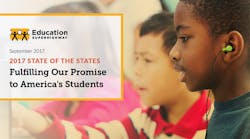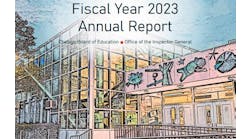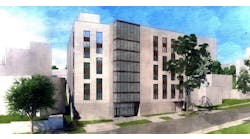Some 6.5 million U.S. students attend school in under-connected facilities, a new report from EducationSuperHighway says.
The non-profit organization's 2017 State of the States reports more than 9,400 schools fall short of the minimum bandwidth goal for digital learning—defined by the FCC as at least 100 kilobits per second (kbps) of internet bandwidth per student.
The numbers also show that 94 percent of school districts meet the Federal Communications Commission’s minimum standards for internet connectivity, and 88 percent of schools self-report that they have sufficient Wi-Fi in their classrooms.
Nine states—Arkansas, Hawaii, Kentucky, North Dakota, South Dakota, Utah, Vermont, West Virginia and Wyoming—have 100 percent of their school districts meeting the FCC's minimum goal.
"But there are still 6.5 million students that need our help," says Evan Marwell, CEO of EducationSuperHighway, a nonprofit organization that advocates for improved internet access to schools. "Without it, these students will not have equal access to the digital opportunities now afforded to nearly 40 million American kids."
The report attributes most of the connectivity gains to changes in the federal E-rate subsidy program.
"In 2017, the progress made possible by E-rate modernization continued, reducing the number of students without high-speed Internet access by 5.1 million and the number of schools without 21st-century broadband infrastructure by 45 percent," the report says.
As connectivity has increased, the costs for K-12 internet access have plummeted, the report says. The median cost per megabits per second has fallen from $22 in 2013 to $4.90 in 2017.
But the report stresses that more work needs to be done to connect more than 2,000 schools that lack fiber connections. More than three-fourths of schools without fiber are in rural communities. These schools either haven’t requested infrastructure upgrades via the E-rate, or are in areas traditionally considered unviable or unprofitable for internet service providers.
EdSurge reports that since Donald Trump has become president, the FCC has reduced its role in getting schools connected, according Marwell.
“We need to see the FCC take a much more proactive approach to getting fiber to these schools," Marwell says. "We have seen a real change in the FCC approval rates for these projects. We’ve seen more red tape, more questions and more rejections of these projects.”
Districts that account for 6 million of the students without access to 100 kbps per student connectivity could meet or exceed that goal within their existing budget by gaining access to a “peer deal,” the report says. Those districts could receive the same rate for internet service that a district of similar size in their state is already getting. According to the report, 58 percent of those districts wouldn’t even have to switch service providers.
At many districts, the 100 kbps per student minimum isn’t enough to support the high bandwidth use that comes along with one-to-one and bring-your-own-device technology initiatives.
According to the report, 85 percent of the nation’s 900 largest districts are providing more than the minimum 100 kbps for their students. Of the districts already meeting connectivity benchmarks, the median bandwidth per student is 411 kbps, and grew 29 percent from 2016 to 2017.


